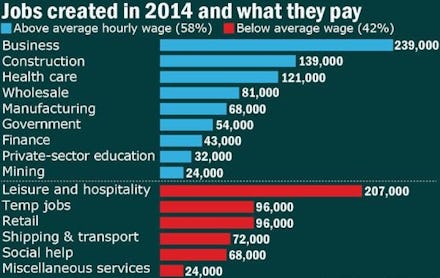There's Some Really Good News for Americans Looking for a Job

The good news: Businesses are hiring! The job market is steadily improving, with more than 288,000 new jobs in June alone — a figure much higher than the 215,000 economists had predicted. Even better, almost 60% of the new positions pay more than $24.45 per hour, the average U.S. wage.
According to MarketWatch, hiring has increased because businesses are starting to hire white-collar workers again and the ravaged construction industry is making a comeback. These are encouraging signs that 2014 might be a much better year for American workers.
Some general specifics: June marked the fifth straight month when more than 200,000 new jobs were created. The unemployment rate also dipped to 6.1%, the lowest since 2008, a major improvement over the sharp winter contraction. Growth in 2014 will likely reach 2%, hitting the lower end of a healthy growth rate of 2-4%.
It's certainly not boom times yet, but this should come as a big relief for long-suffering American workers. Those who already have a job are beginning to spend more for big-ticket items like cars, SUVs and trucks, pointing to a potentially robust acceleration in the economy. And the number of long-term unemployed has dropped by 1.2 million over the course of the last year.
Another positive sign is that unemployment among black people, which economist Thomas Boston describes as "particularly intractable," dropped nearly a full percentage point in June. This makes Boston believe that, "We have finally exited the tunnel."
The not-so-good news: Of course, as we continue to climb our way out of a recession, there are still some challenges. Salaries increased only 2% over the last year, barely keeping up with inflation. And the new jobs might not pay as well as they did in the past: The average annual pay of seven of the top 10 most common occupations is lower than it was in 1999 (when adjusted for inflation).
Certain groups are still doing poorly, like Millennials. A study from the University of Arizona found that just 300 of 1,000 respondents were financially self-sufficient two years out of college, while nearly half said they were dependent on their families — including those with full-time jobs. More than half of Millennials live paycheck to paycheck.
This party also mostly benefits the rich. Recent research by economists Steven Fazzari of Washington University in St. Louis and Barry Cynamon of the Federal Reserve Bank of St. Louis indicates that the good fortunes of the wealthy have mostly driven the current recovery. Between 2009 and 2012, 90% of the overall increase in inflation-adjusted consumption was driven by the top 20%.
"It's going to be hard to maintain strong economic growth with such a large proportion of the population falling behind," Fazzari told the New York Times.
Why you should care: After a devastating recession that wiped out huge swathes of American middle-class wealth, the job numbers suggest that the economy could be poised to give us a bit of a break this year. While there's still a huge amount of work to be done to rebuild the middle class, this is one ray of light in an otherwise cloudy situation.